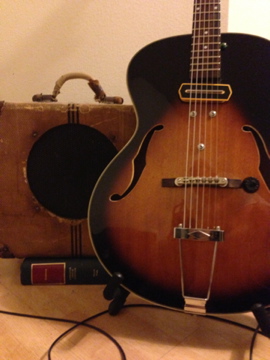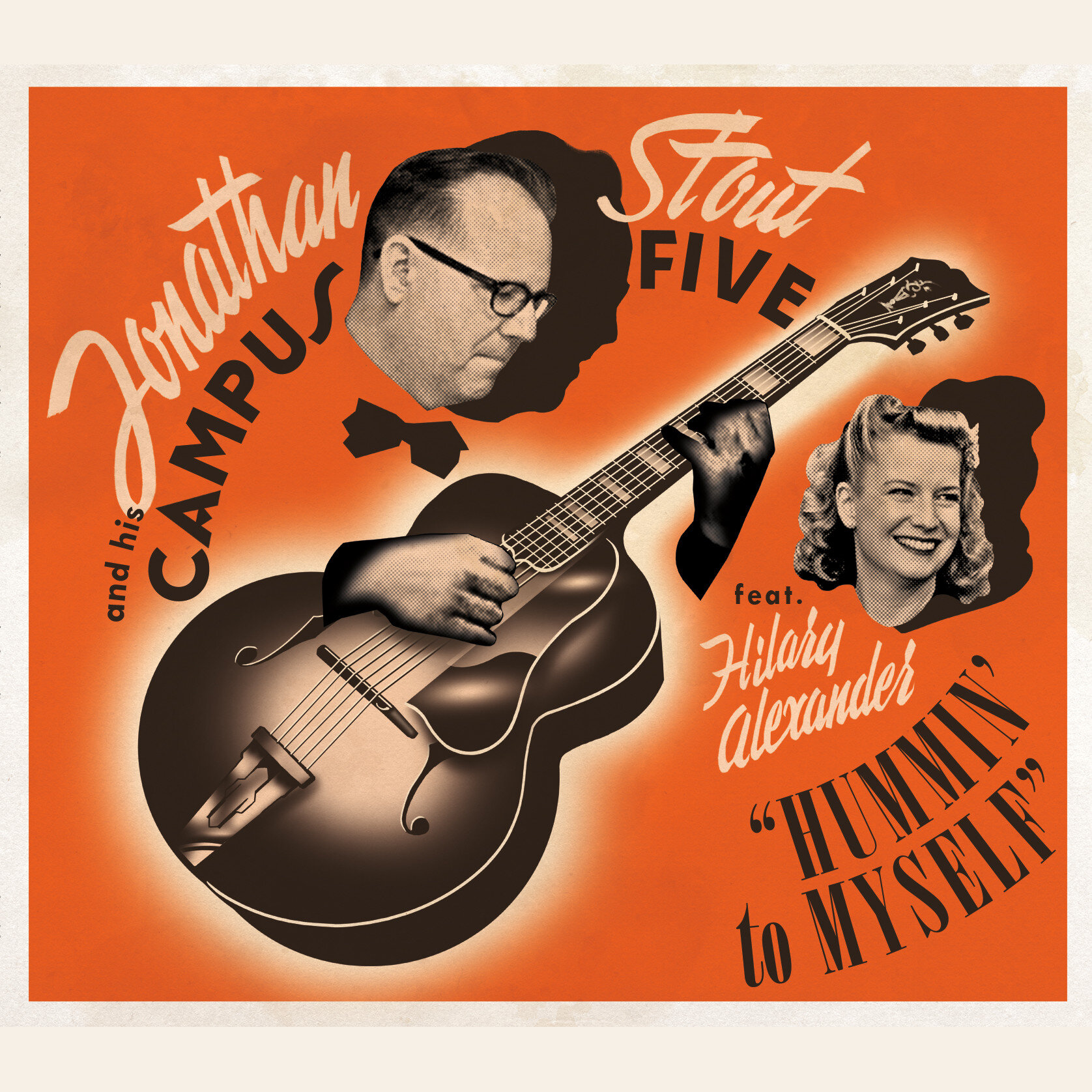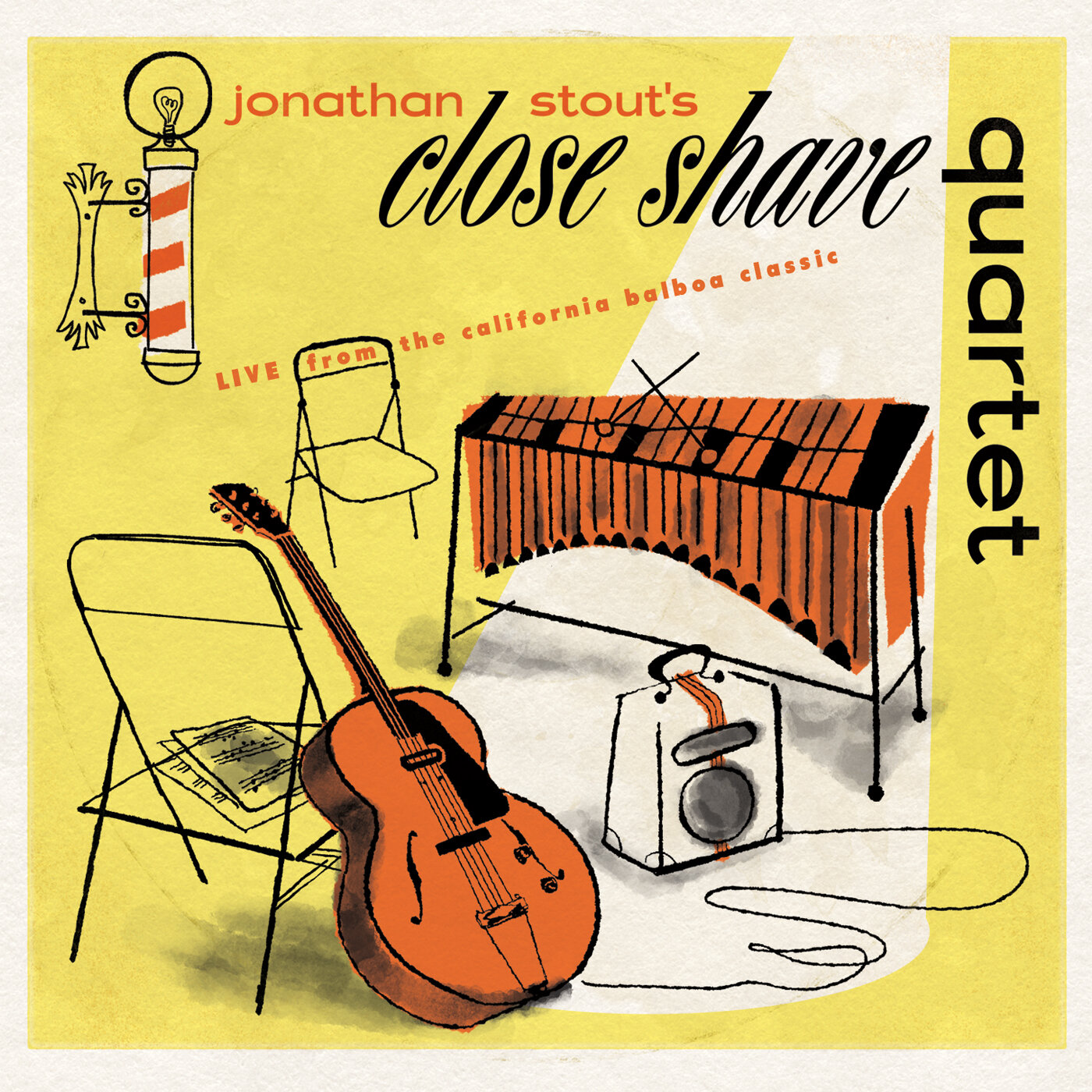More Info about those Awesome Japanese Guitar Players
/Check out the follow up post below, or at /swingguitarblog/2012/9/25/chicken-a-la-swing-ala-japanese.html
Check out the follow up post below, or at /swingguitarblog/2012/9/25/chicken-a-la-swing-ala-japanese.html
And here's one more from this afternoon's practice session: "Six Appeal" (aka "My Daddy Rocks Me").
Another tune we play regularly with the Campus Five, but not one I typically approach so recklessly. What the hell, it's just practice, right?
Six Appeal - guitar jam by campusfive Six Appeal - guitar jam by campusfive
I was browsing around the internet this morning, and dropped by T.K. Smith's Website. For those unaware, T.K. Smith one of the Western/Jazz guitar players anywhere. He's somebody who's references go from Charlie Christian, George Barnes and Barney Kessel to guys like Jimmy Bryant, Roy Lanham, and Junior Bernard. His blog is a fantastic reference point for all things in the vintage guitar world.
One of his regular features is the "Monthly Motivation" where he post a clip or video that is just awesome. Specifically I happened upon this post, about a medley from live radio broadcast featuring Barnel Kessel, Irving Ashby, Arv Garrison and Les Paul. Well that was a jumping off point, as I started listening to a whole stack of favorite electric guitarists, going from George Barnes, early Les Paul, and Mary Osbourne, finishing off with Charlie Christian.
(Funny thing is that I spent the whole morning before this working on some acoustic chord-melody playing, specifically George M. Smith's "Test Pilot" from the "Masters of the Plectrum Guitar" book, because I was so inspired by my new friends Yuji Kamihigashi and Takashi Nakayama - who I just posted about - and their video of the tune. )
Anyway, I quickly recorded some basic chunky, 4 beat rhythm tracks to play over, and then plugged my Franken-ES 150 into my 1936 EH-150, which I never get to play live, because it's so small and fragile.

So the first track is take on rhythm changes, "Moppin' and Boppin'" which is a Fats Waller tune the Campus five regularly plays. It's a rhythm change in F, although the bridge goes (D7 ---- Gm --- G7 --- Db7 / C7). Since I rarely get to play more than a chorus since we're a swing dance band, so I tried to approach each chorus like I was starting from scratch.
"Moppin' and Boppin'"
Moppin' and Boppin' - guitar jam by campusfive Rose Room - guitar jam by campusfive
Next up, the old chestnut, "Rose Room." Similarly
"Rose Room"
Rose Room - guitar jam by campusfive
Here's a great video that really isolates the variable to hear the differences in construction technique and body size between four guitars.
I really love how there's absolutely no variation in the sound samples other than the guitars themselves. Now if we could just do this with a stack of different vintage and modern archtops, we'd really have something!
I've always been bullish on action. I mean, since I started playing acoustic archtops, I've believe that pretty high action was necessary to drive the top of the guitar, so that the maximum acoustic volume can be reached. I've had pretty high action for the last 10 years or so, as a result, and even put on extra heavy high E and B strings to try to make those strings even louder. I'd dealt with set up guys before, and many of them had been clueless the needs of an acoustic archtop - one particularly respected place in Los Angeles told me they did all of Lee Ritenour's guitars, and they could "put .011's on and make the action super low." Of course, it's not suprising to see guys with no appreciation or understanding for our style of playing and guitars.
Well, I had an epiphany the other day that really set me straight. I was at Westwood Music, here in Los Angeles, and picked up a 16" non-cutaway archtop made by a Nashville Luthier named Welker. While the guitar was pretty darn good, what really blew me away was how effortlessly it played and spoke. The intonation was spot on from nut to bridge and it required very little effort to make the guitar just sing. I asked the sales guy on the floor who set up the guitar, and he replied "I did." I of course asked if he would be able to set up my guitar if I brought it in, and he said he'd be happy to take a look, and that turn around time would be a couple of days tops.
Well, this was right before Camp Hollywood, and our 6 night 10th Anniversary run, so I didn't take the guitar in until about the three weeks ago.
When I finally brought the guitar in, I saw the same guy who was stoked to see my Eastman 605. He took a look at it and formulated a perscription. But then he said, "lemme get Dave to take a look at it." My first reaction was "Who the hell is Dave? Screw Dave. You set up that Welker - do the same to my guitar." Of course I didn't say that out loud, but the guy explained that Dave was the guy that showed him everything he knows, so he wanted a second opinion. Dave was really nice, and he basically echoed the other guys perscription, though he would take it one notch further. They asked if I had a couple minutes and they could do it right then - of course I took them up on it. I figured they had that nice Welker still, so I could play while I waited.
When the guitar returned not 20 minutes later, I was stunned. The guitar with the beefy action that I'd been wrestling (and mostly winning) for almost 8 years now played like a dream. The intonation, which had always been a bit compromised with my hybrid guage string set, was now spot on. The action was signifcantly lowered, although it was still high enough to get plenty of volume out of the guitar and not buzz when I dug into the guitar.
But, to be fair it wasn't as loud. And that bummed me out for a second - but then I realized the truth. My previous action was past the point of diminishing returns. I was so high that sustain was compromised, and they led to guitar that was harder to play and less impactful, even if it was technically louder. With such high action, the strings would die the second I released the strings even slightly. So, the guys at Westwood Music found that sweet spot where volume/sustain/playability/intonation all meet perfectly. My guitar has been so inspirining to play because of the set up, that I've been playing more guitar lately than I have in 10 years. Having the intonation be so spot on has inspired me to work more on chord-melody and Allan Reuss-style solos.
There were precursors to my epiphany, and I should've caught them then. Whenever I visit Old Towne Pickin' Parlor outside of Denver, Kit's archtops are always imacculately set up. He was very proud of his in-house luthier, but there was never time to have him work on my guitar while I was traveling for the gig. Also, last visit to Seattle, Dave Brown, our go-to bassist in town, lent me a reconditioned Epiphone Triumph that had been worked on a set up by www.archtop.com. That guitar was similarly inspiring to play, and I took the opportunity several times to play things on that guitar that I would have generally switched to my electric to play. Still, I didn't realize what I was missing until now.
I would highly recommend both www.archtop.com and Old Towne Pickin' Parlor to set up your guitar like an acoustic archtop should be set up. And if you're in Los Angeles, you must go to Westwood Music and ask for "Dave" - he knows his stuff!
So the internets answered the questions left by my hastily typed post. The two guys in this awesome video are Takashi Nakayama and Yuji Kamihigashi. I know this (aside from the fact that it actually says it at the end one of their youtube videos) because I got super nice email from Yuji. Yuji's the one playing the dot neck L-5 style guitar, and Takashi is the gent playing the one with the block inlays. Takashi plays with the Sweet Hollywiians, while Yuji claims not to be a professional. Personally, I think he's got the chops.
I was pretty floored by Yuji's chordal playing. His big three favorites are George Van Eps, Allan Reuss, and Carl Kress, which explains it all. I was wondering if he's playing in standard tuning or going for the Carl Kress extended banjo tuning (Bb, F, C, G, B, D.), and he mentioned he was playing A, E, D, G, B, E, basically combining the bottom two strings from a 7 string with the top 4 of a conventional guitar. He mentioned that's he changed back to standard tuning because it allows him more freedom to improvise.
He sent me a link to another video of him a Takashi, here playing a tune he translated as "Cricket Swing" composed by Yoshihiro Arita. What a great sounding tune - and just listen to that awesome chord solo. Takashi and Yuji are really killing it!
The Sweet Hollywiians will be in California for a couple gigs in October, and I'm definitely going to drop by their show at Boulevard Music in Culver City on 10/19/12: http://boulevardmusic.com/livemusic/382.html
[in the interests of actually putting content up more often, rather than being so precious about it, I've split this up into two articles, and I'm gonna have to add the example clips soon, rather than waiting for them to be ready before I post this.]
YoungWoo Joh, from Orlando, FL recently sent me an email asking me about the interaction of rhythm guitar and piano. Specifically, he was wondering how not having a piano would, could or should change what he does as a rhythm guitarist in his band (the instrumentation of which is clarinet/sax, trombone, guitar, bass, washboard and vocals). He writes:
"I had originally just been chunking through the changes (a la 4/4 rhythm guitar), but I've come to feel that lacking both a piano and third horn makes it feel like something is missing. In response to this, I've made my (guitar) playing a little more rhythmically creative, though always going back to the 4/4 as the basic rhythm. In addition to that, I've slowly been working up my chordal vocabulary (inversions and extensions) in order to imply movement and for the occasional fill.
The thing is that all of this is sort of being done experimentally, and I was hoping you could give me a little more insight on what else I could be doing on guitar to help fill out the sound."
Let's see if any of this helps….
So in part 2, I'll pick up with hitting musical accent figures with the band, and talk about interacting with YoungWoo's particular instrumentation in the next installment.

"Jammin' the Blues" means a lot to me, personally. It brings together Lindy Hop and a unique focus on the musicians who create the music. It was one of the first selections picked to be in the Campus Five's repitoire, and it has closed almost every Campus Five for the last ten years. Some of my proudest and most special moments on stage have been while playing this song. Suffice it to say, I love this film and song.
Shot by famed Life Magazine Photographer Gjon Mili, "Jammin' the Blues" is notable for its inventive look and visual effects, and it was nominated for an Academy Award for Best Short Subject.
But of course, as pretty and striking as it is, "Jammin'" is about the music. It starts off with a jammed slow blues, and segues into a vocal on "On the Sunny Side of the Street." Both are beautiful. However, once the drum solo begins, it gets real. [Side note: Big Sid Catlett is shown playing the first part of the movie, and then he ever so smoothly trades the kit over to Jo Jones - but the audio was recorded seperately first, and so the audio is actually of Jo then trading to Sid] The heavyweights on the session are amazing: Lester Young, Illinois Jacquet (looking downright possessed!), Sweets Edison, Barney Kessel, and of course Jo and Sid.
Barney Kessel was one of the first to pick up on Charlie Christian's revolutionary approach to electric guitar. His early 40's playing is fantastic, though his bop-influenced stuff later on is what everyone else seems to focus on. Kessel has a couple good solos recorded during his stint with Artie Shaw's big band and small group, the Grammercy Five. "Hop Skip and Jump" and "Bedford Drive" are two Shaw tunes with Kessel solos.
For a white kid from Oklahoma, it's notable that Barney was included among the all-stars in "Jammin'", especially considering they were all-black. Given the backwards-ass racial climate of the times, Barney was only shown in shadow, and apparently his hands were stained with grape juice for the shoot, so he'd look darker.
I've been half-heartedly trying to learn Barney's "Jammin'" solo for more than 10 years now. I say "half-heartedly" because I just never sat down to do it right - meaning with something to slow down the audio, and something to notate what I figure out. Well, 10 years got shortened to about 60 minutes tonight, and I finally got it. Since notating the solo was part of what helped me transcribe it (and hear it played back so I could check my work), I figure I could just as easily share it here.
Barney Kessel's solo on "Jammin' the Blues" (1944) - PDF
Here's the tab version:
Barney Kessel's solo on "Jammin' the Blues" (1944) - TAB - PDF
Here's the video - the solo starts at 1:17:



I'm very skeptical when I see youtube videos of people purporting to be lessons on swing rhythm guitar. Most of them are complete crap, and you can usually tell by the pick ups on their guitars - I mean because they have pick ups.
Anyway, I found this clip which gave another reasoning behind the use of three note chords: smooth voice leading. Judging from that 30's-40's Epiphone Emperor, I'm guessing he might have a some idea of what's going on that most of the youtube lessons out there.
Mr. Clark correctly begins by passing much of the credit for the three-note chord system, usually called Freddie Green-style, to George Van Eps. Allan Reuss studied with George before taking George's spot in the Goodman band, and it was Allan Reuss who gave Freddie Green lessons. But his main point is that 6-string barre chords don't really resolve well from one to the next. The fact that there are a bunch of repeated notes makes for odd leaps and unresolved tensions.
While I still feel that the main justification for the three note chord tradition is that the timbre of the three note chord cuts through the band better, sonically, it is clear that you can much more effectively voice lead with the three note chords. Here's the video:

Hummin’ to Myself (2021)

“LIVE from the California Balboa Classic” (2021)
Jonathan Stout
+1 (818) 486-7637
jonathan.stout@gmail.com
Hilary Alexander
+1 (323) 276-3841
info@camphollywood.net
Copyright 2003–2017 Jonathan Stout and his Campus Five. All rights reserved.